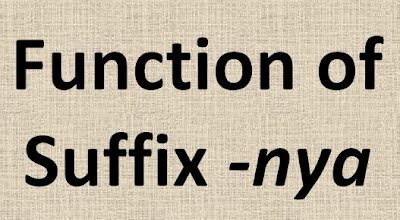2.4
Function of Suffix -nya
Suffix [-nya] also principally has its own
functions in Indonesia. According to Sneddon, suffix [-nya] can be divided into seven functions, among those: as a
possessive pronoun, object pronoun, an agentive object, a determiner,
nominalizer, an adverbializer, and indefinite number. Each function of suffix [-nya] is explained below:
2.4.1
Suffix [-nya] as possessive pronoun
Possessive pronoun in
English is described as a pronoun which shows a possessive of something or
someone. In Indonesian, suffix [-nya]
can be used to show a possession, in this case as a possession of a singular or
plural person. This suffix has several functions within the noun phrase. It can
functions as third person possessive pronoun (Sneddon, 1996: 150)
For examples:
1)
SL:
Dia menantikan Ola, suaminya.
TL: he a waited Ola, her husband (Sneddon, 1996: 158)
2) SL:
Dimana rumahnya?
TL:
Where do you live?(Literally: where is her/his house) (Sneddon, 1996: 163)
In example above, all
suffix [-nya], function as a
possessive pronoun. This suffix is attached to nouns, such as to the nouns suami, and rumah. Because its functions as possessive pronouns, it means that
all suffix [-nya] attached to the
words above show possession. Because of showing possession, so the words in
examples above can be further defined into suami
dia or suaminya, and in another
example rumah dia or rumahnya.
2.4.2
Suffix [-nya] is translated into
Object Pronoun
Suffix [-nya] functioning as object pronoun can
be gotten after noun in active sentences. It has the meaning of dia. It is translated into object
pronoun like her and him.
Example:
SL: Narti menunggunya (Sneddon, 1996: 165)
TL: Narti is waiting for him (Sneddon, 1996: 165)
In example above suffix
[-nya] in the word menunggunya is translated into him in target language. And if we look
at English function suffix [-nya] has
functions as object pronoun.
2.4.3
Suffix [-nya] as an Agentive Object
Suffix [-nya] functions as an agentive object
means that the [-nya] receive an
action of the object. It is usually found in passive sentences. The example of
the [-nya] which as an agentive
object is:
1) SL:
Narti ditunggunya
TL: He is
waiting for narti (Sneddon, 1996: 166)
The function of the [-nya] in this example is an agentive
object. The [-nya] in this sentence
is placed after a passive verb like ditunggu
+ nya. In this case it does not have function as possession. In the example
above suffix [-nya] is translated
into he in English.
2.4.4
Suffix [-nya] as a Determiner
The [-nya] functioning as determiner means
that suffix [-nya] in this case as a
determining word, which is usually put after noun. It can also attached to the
head of noun, being translated into the.
This can occur where the noun has not been mentioned before, but is understood
within the context of the utterance (Sneddon, 1996: 150)
1)
SL:
Kalau mau makan, nasinya dilemari
TL: If you want to eat, the rice is in the pantry (Sneddon, 1996: 151)
2) SL:
Saya mau kekantor pos tetapi tidak tahu jalannya
TL:
I want to go to the post office but I don’t know the way (Sneddon, 1996: 151)
In the examples above,
all the [-nya] are used as
determiner. Determiner means the words that modify a noun. In this situation
the [-nya] does not have lexical
relation meaning with dia. The [-nya] in (1) nasinya and (2) jalanya
are determiners, the [-nya] only
functions to determine a thing expressed by the speaker.
2.4.5
Suffix [-nya] as an Adverbializer
The use of the [-nya] functioning as an adverbializer
means that suffix [-nya] is used to
form an adverbial phrase or an object complement of a sentence. The function of
suffix [-nya] as an adverb can be
seen from the sentences bellows:
SL: Rupanya dia tidak akan lulus
TL: It seems
as if he will not pass (Margono, 1999: 19)
In example above, the
word rupanya is translated into the
word seems in English. Rupanya is combined with the word rupa + suffix [-nya]. In this sentences, suffix [-nya] functions as an adverbial phrase. In example above, it is used
to form adverb rupanya as
adverbializer.
2.4.6
Suffix [-nya] as Nominalizer
Nominalized adjectives
of measure only take [-nya]
obligatorily if there is no other possessor expressed. In the presence of a
first or second person possessor [-nya]
cannot occur (Sneddon, 1996: 306)
1) SL:
Beratnya sepuluh kilo.
TL: Its
weight is ten kilos (Sneddon, 1996: 306)
2) SL:
Gunung itu tingginya 2000 m
(Margono,1999:19)
TL:
The Mountain, its height is 2000 m
(Margono, 1999:19)
In example (1) Suffix
[-nya] changes the adjective which is stated by word berat into noun beratnya
as nominalizer. And in example (2) suffix [-nya]
changes the adjective which is stated by word tinggi into noun tingginya
as nominalizer which refers to the noun gunung
itu.
2.4.7
Suffix [-nya] as indefinite numbers
According to Sneddon in
her book entitled Indonesia Reference Grammar,
several indefinite numbers can occur as pronouns, in which case they taken
suffix[-nya] (Sneddon,1996: 175). The
[-nya] functions as indefinite
numbers can be given in examples bellow:
1) SL:
Semuanya (Sneddon: 1996: 175)
TL: All of them (Sneddon: 1996: 175)
2) SL:
Seluruhnya (Sneddon: 1996: 175)
TL: All of it (Sneddon: 1996: 175)
In example (1) suffix
[-nya] indicates an indefinite number
from word semuanya and when it is
translated into English, suffix [-nya]
refers to the pronoun which is stated by pronoun them. And in example (2) suffix [-nya] shows indefinite number from word seluruh and when it is translated into English suffix [-nya] refers to the pronoun which is
expressed by pronoun it.
Credits: Dana


